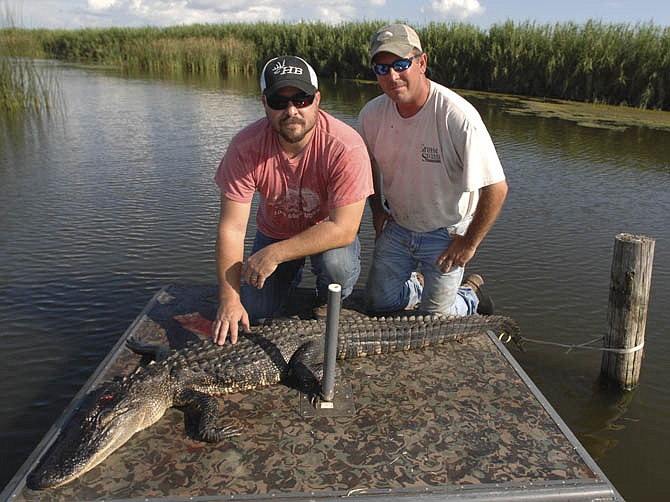Yes. It was just like the television show Swamp People.
I thought I'd go ahead and get that out of the way because no matter who I am speaking with it, seems to always be the first question asked.
There are different methods of hunting alligators across the south.
In Louisiana, you set lines just as you would when limb lining for catfish. Usually you set the lines in the evening and come back to check them in the morning. You can set them during the day and continuously watch them if you wish, but the overnight method is the most popular.
The setup is fairly simple. If a tree is available you use it. If not, a post of some sort is driven into the bank or the bottom of the swamp. A rope is tied to the tree or post. The ropes we were using were about 25 feet long. At the end of the rope is a large hook. I mean large, like bigger than your finger curled over.
Next to the post, a pole is placed at a 45-degree angle. We used bamboo in this case. There's a clothespin placed up the pole, which the rope is clipped into leaving the bait dangling above the water. In our case, the bait was chicken.
"I like to use chicken because it's not expensive, it stays on the hooks and as it heats up it drips an oily residue on the surface of the water. Gators smell that residue and come looking for the source," said captain Doug Miller, my guide.
Once a gator takes the bait, it'll stretch the rope out looking for a place to hide. This could be in the cattails next to shore or simply down on the bottom. If the rope is not apparent, you search for it with a small rake. Once located, you pull the rope in by hand bringing an angry alligator to the side of your boat mere inches from your feet. Then all hell breaks loose.
The goal is to quickly and humanely dispatch the gator with a single bullet to the head. We used a .22 magnum lever-action rifle. You must put the bullet in an area directly behind the gators eyes roughly the size of a dollar bill torn in half. Miss your mark and you'll have one angry beast beating at the side of your boat.
Once you have a gator close to the boat, it will typically begin thrashing to get away. It's powerful tail may slap the boat causing it to jolt, knocking you of balance. The fear of falling over the side into water with a creature that can easily take off one your appendages is a constant scare. Alligator hunting is thus best done in teams. One person works the gator on the rope while the other tries to put a well-placed bullet in its brain.
If you've ever watched Swamp People, then you're familiar with "Choot "em." This is what one of the show's stars constantly yells as he's wrestling the gator rope waiting on his mate to shoot the gator. Shooting the beast is no easy task. I learned firsthand how hard it is to get the shot you're looking for. The gator is constantly moving, thrashing and rolling, and you're trying to be precise with your shot placement. It's tough and exhilarating.
My alligator hunt took place at Grosse Savanne. This magnificent lodge is situated on 75,000 private acres. The accommodations are impeccable, the food exquisite and scenery unimaginable. Gators were everywhere. My boat baited 23 lines and took in 11 alligators ranging in size from 7-10 feet long.
If you've dreamed of going on an alligator hunt, I highly encourage you to do so. The experience is like nothing I've done before. Being in the swamp chasing modern day dinosaurs is as unique and heart-pounding as hunting gets. Every piece of the gator is used, from the meat to the skin.
See you down the trail ...
III
Brandon Butler is an outdoors columnist for the News Tribune. He can be reached at [email protected].

